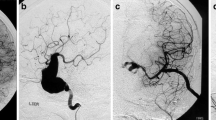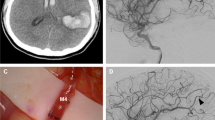Abstract
The purpose of this study was to investigate the application and efficacy analysis of in situ interposition bypass in complex intracranial aneurysms. This study retrospectively analyzed the clinical data of 21 patients with complex intracranial aneurysms treated with in situ interposition bypass grafting in the Department of Neurosurgery at Tianjin Huanhu Hospital from June 2015 to December 2022. The aneurysms were located in the middle cerebral artery in 16 cases, the anterior cerebral artery in 3 cases, the posterior cerebral artery in 1 case, and the posterior inferior cerebellar artery in 1 case. The interposition graft vessels were taken from the radial artery in 15 cases, the superficial temporal artery in 5 cases, and the occipital artery in 1 case. All patients underwent end-to-end anastomosis with in situ interposition bypass after aneurysm resection, including 13 cases of "I-shaped" type, 5 cases of "V-shaped" type, and 3 cases of "Y-shaped" type. Postoperative digital subtraction angiography (DSA) or computed tomography angiography (CTA) reviews were performed for all the patients, and modified Rankin Scale (mRS) score was used to assess patient prognosis. Three patients developed postoperative basal ganglia infarction and two of them recovered well. One case developed transient incomplete aphasia and one case developed mild hemiparesis, which recovered well after 3 months. The remaining 16 patients did not develop new neurological deficits. Postoperative DSA or CTA showed that the anastomosis of the bypass graft and the graft vessels were patent, and all aneurysms were completely eliminated. Regular postoperative follow-up ranged from 3 to 89 months, and no aneurysm recurred. The percentage of patients with mRS ≤ 2 at the final follow-up was 90.5%. Based on the experience of surgical treatment in our center, in situ interposition bypass technique is a safe and effective option for the treatment of some complex intracranial aneurysms.




Similar content being viewed by others
Data availability
The data and materials supporting this study can be obtained from the corresponding author upon reasonable request.
References
Lee KS, Zhang JJY, Nguyen V et al (2022) The evolution of intracranial aneurysm treatment techniques and future directions. Neurosurg Rev 45(1):1–25. https://doi.org/10.1007/s10143-021-01543-z
TayebiMeybodi A, Huang W, Benet A, Kola O, Lawton MT (2017) Bypass surgery for complex middle cerebral artery aneurysms: An algorithmic approach to revascularization. J Neurosurg 127(3):463–479. https://doi.org/10.3171/2016.7.Jns16772
Quiñones-Hinojosa A, Lawton MT (2008) In situ bypass in the management of complex intracranial aneurysms: Technique application in 13 patients. Neurosurgery 62(6 Suppl 3):1442–1449. https://doi.org/10.1227/01.neu.0000333808.64530.dd
Wang L, Cai L, Qian H et al (2019) Intracranial-intracranial bypass with a graft vessel: A comprehensive review of technical characteristics and surgical experience. World Neurosurg 125:285–298. https://doi.org/10.1016/j.wneu.2019.01.259
Abla AA, Lawton MT (2014) Anterior cerebral artery bypass for complex aneurysms: An experience with intracranial-intracranial reconstruction and review of bypass options. J Neurosurg 120(6):1364–1377. https://doi.org/10.3171/2014.3.Jns132219
Kaku Y, Takei H, Miyai M, Yamashita K, Kokuzawa J (2016) Surgical treatment of complex cerebral aneurysms using interposition short vein graft. Acta Neurochir Suppl 123:65–71. https://doi.org/10.1007/978-3-319-29887-0_9
Zhu W, Liu P, Tian Y et al (2013) Complex middle cerebral artery aneurysms: A new classification based on the angioarchitecture and surgical strategies. Acta Neurochir (Wien) 155(8):1481–1491. https://doi.org/10.1007/s00701-013-1751-8
Jarvis MA, Jarvis CL, Jones PR, Spyt TJ (2000) Reliability of Allen’s test in selection of patients for radial artery harvest. Ann Thorac Surg 70(4):1362–1365. https://doi.org/10.1016/s0003-4975(00)01551-4
Awad AJ, Mascitelli JR, Haroun RR, De Leacy RA, Fifi JT, Mocco J (2017) Endovascular management of fusiform aneurysms in the posterior circulation: The era of flow diversion. Neurosurg Focus 42(6):E14. https://doi.org/10.3171/2017.3.Focus1748
Bhide AA, Yamada Y, Kato Y et al (2020) Surgical management of complex middle cerebral artery aneurysms: An institutional review. Asian J Neurosurg 15(4):959–965. https://doi.org/10.4103/ajns.AJNS_5_20
Griessenauer CJ, Ogilvy CS, Adeeb N et al (2018) Pipeline embolization of posterior circulation aneurysms: A multicenter study of 131 aneurysms. J Neurosurg 130(3):923–935. https://doi.org/10.3171/2017.9.Jns171376
Nussbaum ES, Kallmes KM, Lassig JP, Goddard JK, Madison MT, Nussbaum LA (2018) Cerebral revascularization for the management of complex intracranial aneurysms: A single-center experience. J Neurosurg 131(4):1297–1307. https://doi.org/10.3171/2018.4.Jns172752
Davies JM, Lawton MT (2014) Advances in open microsurgery for cerebral aneurysms. Neurosurgery 74(Suppl 1):S7-16. https://doi.org/10.1227/neu.0000000000000193
Abla AA, McDougall CM, Breshears JD, Lawton MT (2016) Intracranial-to-intracranial bypass for posterior inferior cerebellar artery aneurysms: Options, technical challenges, and results in 35 patients. J Neurosurg 124(5):1275–1286. https://doi.org/10.3171/2015.5.Jns15368
Connolly F, Alsolivany J, Czabanka M et al (2021) Blood volume flow in the superficial temporal artery assessed by duplex sonography: Predicting extracranial-intracranial bypass patency in moyamoya disease. J Neurosurg 135(6):1666–1673. https://doi.org/10.3171/2020.9.Jns202709
Makihara E, Masumi S (2008) Blood flow changes of a superficial temporal artery before and after low-level laser irradiation applied to the temporomandibular joint area. Nihon Hotetsu Shika Gakkai Zasshi 52(2):167–170. https://doi.org/10.2186/jjps.52.167
Natarajan SK, Zeeshan Q, Ghodke BV, Sekhar LN (2019) Brain bypass surgery for complex middle cerebral artery aneurysms: Evolving techniques, results, and lessons learned. World Neurosurg 130:e272–e293. https://doi.org/10.1016/j.wneu.2019.06.059
Ostrowski P, Bonczar M, Plutecki D et al (2023) The occipital artery: A meta-analysis of its anatomy with clinical correlations. Anat Sci Int 98(1):12–21. https://doi.org/10.1007/s12565-022-00693-4
Tomizawa M, Hori S, Nishimura N et al (2020) Arterial reconstruction using the donor’s gonadal vein in living renal transplantation with multiple renal arteries: A case report and a literature review. BMC Nephrol 21(1):190. https://doi.org/10.1186/s12882-020-01848-z
Matsukawa H, Tanikawa R, Kamiyama H et al (2017) Graft occlusion and graft size changes in complex internal carotid artery aneurysm treated by extracranial to intracranial bypass using high-flow grafts with therapeutic internal carotid artery occlusion. Neurosurgery 81(4):672–679. https://doi.org/10.1093/neuros/nyx075
Morton RP, Moore AE, Barber J et al (2014) Monitoring flow in extracranial-intracranial bypass grafts using duplex ultrasonography: A single-center experience in 80 grafts over 8 years. Neurosurgery 74(1):62–70. https://doi.org/10.1227/neu.0000000000000198
Sato R, Mikami T, Suzuki H et al (2020) Natural Y-shaped radial artery graft bypass for a complex middle cerebral artery aneurysm: A case report. J Stroke Cerebrovasc Dis 29(7):104853. https://doi.org/10.1016/j.jstrokecerebrovasdis.2020.104853
Peeters SF, Colby GP, Kim WJ et al (2023) Arterial bypass in the treatment of complex middle cerebral artery aneurysms: Lessons learned from forty patients. World Neurosurg. Available via DIALOG. https://doi.org/10.1016/j.wneu.2023.10.037
Das KK, Balachandar D, Pattankar S, Srivastava AK, Jaiswal AK (2022) An alternative surgical treatment of Giant serpentine aneurysm of the middle cerebral artery: Resection and end-to-end anastomosis. World Neurosurg 161:152. https://doi.org/10.1016/j.wneu.2022.02.100
Wessels L, Fekonja LS, Vajkoczy P (2019) Bypass surgery of complex middle cerebral artery aneurysms-technical aspects and outcomes. Acta Neurochir (Wien) 161(10):1981–1991. https://doi.org/10.1007/s00701-019-04042-9
Ravina K, Strickland BA, Rennert RC et al (2019) A3–A3 anastomosis in the management of complex anterior cerebral artery aneurysms: Experience with in situ bypass and lessons learned from pseudoaneurysm cases. Oper Neurosurg (Hagerstown) 17(3):247–260. https://doi.org/10.1093/ons/opy334
Wang L, Cai L, Qian H, Lawton MT, Shi X (2018) The in situ side-to-side bypass technique: A comprehensive review of the technical characteristics, current anastomosis approaches, and surgical experience. World Neurosurg 115:357–372. https://doi.org/10.1016/j.wneu.2018.04.173
Acknowledgements
We thank Hong Ji and Jie Qiao for clinical data support and all the patients treated in our medical center.
Funding
The authors declare that no funds, grants, or other support were received during the preparation of this manuscript.
Author information
Authors and Affiliations
Contributions
The corresponding author Xiaoguang Tong contributed to the study conception and design. Material preparation, data collection and analysis were performed by Meng Zhang and Xingdong Wang. The first draft of the manuscript was written by Meng Zhang and all authors commented on previous versions of the manuscript. All authors read and approved the final manuscript.
Corresponding author
Ethics declarations
Ethics approval
Approval was granted by the Tianjin Huanhu Hospital Research Ethics Committee.
Consent to participate
Informed consent was obtained from all individual participants included in the study.
Consent to publish
The authors affirm that human research participants provided informed consent for publication of the images in Figs. 2, 3 and 4.
Competing interests
The authors declare no competing interests.
Additional information
Publisher's Note
Springer Nature remains neutral with regard to jurisdictional claims in published maps and institutional affiliations.
Rights and permissions
Springer Nature or its licensor (e.g. a society or other partner) holds exclusive rights to this article under a publishing agreement with the author(s) or other rightsholder(s); author self-archiving of the accepted manuscript version of this article is solely governed by the terms of such publishing agreement and applicable law.
About this article
Cite this article
Zhang, M., Wang, X. & Tong, X. In situ interposition bypass for complex intracranial aneurysms: A single-center experience and efficacy analysis. Neurosurg Rev 47, 32 (2024). https://doi.org/10.1007/s10143-023-02266-z
Received:
Revised:
Accepted:
Published:
DOI: https://doi.org/10.1007/s10143-023-02266-z




